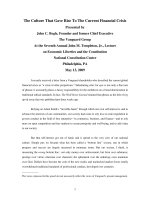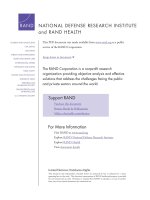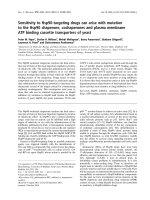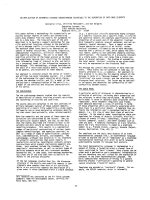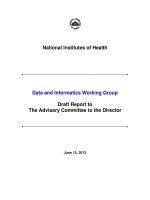UNDERSTANDING DATA: CAN NEWS MEDIA RISE TO THE CHALLENGE?
Bạn đang xem bản rút gọn của tài liệu. Xem và tải ngay bản đầy đủ của tài liệu tại đây (3.2 MB, 40 trang )
Understanding Data:
Can News Media Rise to the Challenge?
By Tara Susman-Peña
June 2, 2014
The Center for International Media Assistance (CIMA), at the National
Endowment for Democracy, works to strengthen the support, raise the
visibility, and improve the effectiveness of independent media
development throughout the world. The center provides information,
builds networks, conducts research, and highlights the indispensable role
independent media play in the creation and development of sustainable
democracies. An important aspect of CIMA’s work is to research ways to
attract additional U.S. private sector interest in and support for
international media development.
CIMA convenes working groups, discussions, and panels on a variety of
topics in the field of media development and assistance. The center also
issues reports and recommendations based on working group discussions
and other investigations. These reports aim to provide policymakers, as
well as donors and practitioners, with ideas for bolstering the effectiveness
of media assistance.
Mark Nelson
Senior Director
Center for International Media Assistance
National Endowment for Democracy
1025 F Street, N.W., 8th Floor
Washington, DC 20004
Phone: (202) 378-9700
Fax: (202) 378-9407
Email:
URL:
About the Author
Tara Susman-Peña is senior research officer for the Internews Center for Innovation
and Learning, focusing on both the evaluation of pilot projects and broader research
on innovation and policy. Before joining Internews, Susman-Peña worked in audience
research at NPR, where she managed the online listener panel and qualitative research
initiatives. Prior to joining NPR, her years of commercial market research experience
focused on branding, video ethnography, product and service development, and
communication strategy in the media, technology, health, food, fashion, and automotive industries. She is the
author of a 2012 CIMA report, Making Media Development More Effective.
Acknowledgements
This report is based on desk research and the author’s interviews, conducted in person, or by Skype, phone, or
e-mail between February and June 2013 with: Alberto Cairo, Ying Chan, Darcy Christ, Eva Constantaras, Sandra
Crucianelli, Anyong Cui, Steve Doig, David Donald, Craig Hammer, Mark Horvit, Brant Houston, Ida Jooste, Dave
Kaplan, Jennifer LaFleur, Yolanda Ma, Nils Mulvad, Dorothy Otieno, Djordje Padesjski, Miguel Paz, Aaron Presnall,
Paul Radu, Margaret Renn, Giannina Segnini, Dan Sinker, Elisa Tinsley, and Jose Roberto de Toledo. Many thanks
to the interviewees for their contributions.
cima.ned.org #DDJ 3
Table of Contents
Introduction 5
Trends and Opportunities 6
Challenges 14
Meeting the Challenges 20
Conclusion 27
Appendix A: Case Studies 28
Appendix B: Resources
See CIMA Website at: www.cima.ned.org
Endnotes 35
4 Center for International Media Assistance
Introduction
Worldwide, data in digital form is being produced at a dizzying pace, not only by governments, academic
institutions, and private enterprises gathering it for their own uses but also as a by-product of millions of routine
interactions on computers, cellphones, GPS devices, and other digital tools. Data is rapidly exploding in quantities
far vaster than the capacity of civil society, commercial entities, and individual citizens to make sense of it.
This presents an opportunity–if not a duty–for news media to play an important role in helping to analyze
and digest all this information through the practice of data journalism, also referred to as “computer-assisted
reporting,” “data-driven journalism,” or “precision journalism.” It also presents an opportunity for the media
development sector to have a notable impact on human development by equipping journalists and media
institutions with the ability to make sense of data for citizens. This report considers the implications of the rise of
data journalism for the media development field.
cima.ned.org #DDJ 5
Trends and Opportunities
With openness increasingly held up as a democratic value, governments are under more pressure to open
to public view the vast amounts of data they collect on their populations. A wealth of data on education,
agriculture, health, finance, licensing, crime— is available, if only governments can organize it and make
it available. Citizen and civil society groups are pushing for greater transparency and accountability of
governments, and the call for open government goes hand in hand with a demand for open data.
The push for open government data comes both from above and from below. In June 2013 at the G8 summit,
leaders signed on to an Open Data Charter, which outlines recommendations and broad best practices for
releasing government data. The opening lines of the charter provide a good characterization of the increasingly
global socio-political context around data and signal a growing need for journalists to act as data interpreters:
The world is witnessing the growth of a global movement facilitated by technology and social
media and fuelled by information–one that contains enormous potential to create more
accountable, efficient, responsive, and effective governments and businesses, and to spur
economic growth. Open data sit at the heart of this global movement.
From civil society, the Global Open Data Initiative was launched the same month as the Open Data Charter by
The World Wide Web Foundation, the Sunlight Foundation, Fundar, the Open Knowledge Foundation, and the
Open Institute. The idea driving this initiative is to ensure that the open government data initiatives are useful
and impactful. The very existence of this initiative signals that simply opening government data to the public
is not enough to ensure meaningful engagement with that data. The need for “infomediaries” such as data
journalists to help facilitate this engagement is more salient than ever.
Under the Kenya Open Data Initiative, Kenya was the first developing country to open its government data, in
2011. All countries that sign on to the Open Government Partnership agree as part of their action plans to show
progress in access to information, including facilitating access to government data.
This is all very promising, but all countries have a way to go before journalists and others have broad access to
government data–not just national data, but also data from local governments. Governments have not yet met
the public demand for data that is tied to the demand for transparency and accountability. Journalism professor
Steve Doig of Arizona State University observed, “This should be the default: Records should be open to the
people who pay for them: taxpayers. This isn’t widespread in Europe yet.” In the countries where data has been
6 Center for International Media Assistance
Growth in Participation in the Open Government Partnership
Since 2011, the number of countries participating in the Open Government Partnership has grown from 8 to the 63 indicated
on the map above. Map: www.opengovpartnership.org.
Freedom House Freedom of the Press Ratings
Participant Countries Non-participant Countries
Free
Partly Free
Not Free
There is a substantial disparity in Freedom House ratings between countries that participate in the Open Government Partner-
ship and those that do not.
cima.ned.org #DDJ 7
opened, there has not been an automatic increase in government transparency or accountability. Kenya,
where the legislature passed a new restrictive media law in December 2013, is an unfortunate example of a
rise in countervailing forces following on the heels of an open data initiative.
Having more access to government data does not automatically increase citizen understanding or
participation. The 2013 Open Data Barometer found that open data had an extremely limited impact on
77 countries in six key areas, represented below. Note that potential scores were on a scale of 0-10. While
transparency and accountability scored the highest, overall the mean scores are disappointingly low.
Impact of Open Data
Transparency and Accountability
Entrepreneurial Open Data Use
Government Efficiency
Economic Growth
Environmental Sustainability
Inclusion of Marginalized Groups .5 1 1.5 2.0
0
Average across all countries of response to expert survey question.
Clearly there is still a great need–perhaps now more than ever–for reliable guides through the mass of
information who can pinpoint how data is relevant to people’s lives and can interpret data so that people
can use it for decision-making, including participating in the governance of their countries. “People say, do
we need journalists now?” said journalism professor Brant Houston of the University of Illinois. “I say, we need
8 Center for International Media Assistance
them more than ever. It’s one thing to do a data run; it’s another to do fieldwork and interviews and analyze it.”
Journalists have a huge opportunity to craft stories from the government data already available and to join with
advocates in continuing to press for more and better open government data.
The World Economic Forum in 2012 argued for the creation of a “data commons … in which this information
benefits society as a whole while protecting individual security and privacy.” From a development perspective,
the report argues, researchers with access to this data could perform analyses to more accurately determine the
needs of populations and better provide services. While a global “data commons” is still a fantasy, clearly data is
not just for scientists anymore.
The proliferation of data offers the opportunity for journalists to help people understand what it means and how
broader trends are relevant to them. Much of the buzz around digital data has focused on new opportunities
for businesses to understand consumers. But journalists, to the extent that they can access this commercial
data, can be the channels through which others can learn from this information. Despite limitations in access to
data in many countries, the reality, according to data journalists, is that data is growing at a pace that makes it
impossible for journalists to ignore.
As various types of data have grown in quantity (more than 50 percent per year, by some estimates), data
analysis has become a necessary skill in a variety of professions, including journalism. As traditional journalists
have grown their data skills, the flood of data has moved some non-journalists with computer skills closer to
journalism, increasing opportunities for journalists and hackers to collaborate.
Where resources may be scarce, the Internet offers opportunities to create new types of independent media.
Journalists can present stories in new ways that respond to increasing audience interest in engaging with
content as opposed to simply consuming it. These trends help set the stage for reinventing the newsroom and
making it more responsive to citizen needs and interests. Data reporting often leverages these trends, producing
interactive applications that engage audiences.
Data journalism also benefits from broader trends in collaboration as a primary mode of work. It requires a
range of skills, and is best performed by a diverse team including journalists, data analysts, designers, and
programmers. Collaboration in data journalism can also enable better cross-border reporting (often leveraged
for reporting on corruption), allow skill sharing, and facilitate the production of news apps. On the flip side,
cima.ned.org #DDJ 9
cultural impediments to such collaboration can be a barrier to doing data journalism. In China, according to
journalism student Cui Anyong, “The lack of communication among people of different backgrounds is the
major reason that limits the development of data journalism. Everything is just at the beginning point.”
Not only has new technology produced an abundance of new data; digital technology has produced better,
easier tools to work with data. Much analysis that 40 years ago required a mainframe computer that was difficult
to access, complicated to operate, and costly to use, today can be done with free or low-cost Web-based
tools. The open source movement, which functions by sharing and collaboration, has been a driving factor
in increasing access and simplification of digital tools. Costs that can hit at various points of the analysis and
reporting process–connectivity, storage, devices, the tools themselves–are dropping. The ability to visualize
data analysis, from simple but powerful static bar charts to complicated interactive visualizations, has been
transformed. The existence of simpler tools means that it is easier to do sophisticated analysis without having to
understand as much technical detail on the programming end about how the Web-based tools function.
Underlying access to tools is a surge in connectivity–Internet access and speed. According to ITU data, the world
average for individuals using the Internet is still just below 40 percent. Nonetheless, during the last decade there
has been steady growth across the globe:
Individual Access per 100 people Increase in individual access to the Internet since 2005 Developed World
Developing World
**Figures for 2012 and 2013 are estimates. Global
80
70
60
50
40
30
20
10
0 2005 2006 2007 2008 2009 2010 2011 2012* 2013*
10 Center for International Media Assistance
Increased access to better and cheaper tools, of course, in no way obviates the knowledge and skills required to
work with data and with the tools themselves. Data will not analyze itself. However, for those with the skills or the
willingness to build them, these tools, together with rising rates of connectivity, significantly facilitate the process.
With the advent of social media and citizen journalism, the definition of journalism itself has been undergoing
transformation. In the face of increased ability for citizens to publicly tell stories and engage in various of
forms of reporting, some trained professional journalists’ use of data gives them some distinction. “Credibility
is the ultimate goal. That’s why a lot of us got into this [data journalism],” Brant Houston said. The danger,
of course, is that numbers can give the impression of being more trustworthy than other sources, even
though data is produced by people and thus is subject to human fallibility. However, when journalists make
interactive data available online, others can verify stories, check how journalists drew conclusions, and even
come to their own conclusions. Some journalists have taken the opportunity to be more transparent about
their newsgathering, for example offering video tutorials to explain how the story was done and guidance on
using tools to further explore the data.
Not all data journalism is high-quality journalism, of course, but data journalism, when done well, has a lot
to add to traditional reporting techniques. According to Ida Jooste of Internews in Kenya, data journalism
“helps journalists move away from ‘he said, she said,’ kind of journalism; not just unverified opinion, or just
political rather than factual. It helps journalists be more independent, better watchdogs, and fact-check
what people are saying.” Of course, data journalism is not the only way to do this kind of reporting, but it is
another tool in the toolbox.
Cross border, collaborative partnerships often contribute to impactful work. The use of data in reporting
also increases transparency in journalism, particularly when the datasets are provided for audiences to test
the journalists’ analysis.
A few key examples illustrate the strength and range of high quality data journalism coming from both
developed and developing countries, and collaborations across regions. They are examples of projects that
take on daunting amounts of data, require many months (sometimes years) of work, and employ large teams of
journalists throughout the world. The scale of this work is not realistic for the large majority of news outlets, and
excellent, important work can be done with much smaller, localized datasets. Nonetheless, these examples give
a taste of the promise of data journalism.
cima.ned.org #DDJ 11
Offshore Leaks project. While the International Consortium of Investigative Journalists (ICIJ) is based in
Washington, DC, the mission of the project is to produce reporting about issues that cross borders using a
network of journalists from around the world and a range of reporting techniques, including data analysis. The
introduction to Offshore Leaks begins, “A cache of 2.5 million files has cracked open the secrets of more than
120,000 offshore companies and trusts, exposing hidden dealings of politicians, con men and the mega-rich the
world over.” The reporting was intensive. “Eighty-six journalists from 46 countries used high-tech data crunching
and shoe-leather reporting to sift through emails, account ledgers and other files covering nearly 30 years.” The
database for this project had to be built by the reporters for the project. Products include print (digital) articles,
videos, interactive visualizations, and an eBook. In addition to the extensive reporting, the database is available
for interested people to explore. There is also an explanation of how La Nación in Costa Rica built the database,
which journalist Giannina Segnini describes with a powerful metaphor: “An art restorer is able to rebuild a
broken sculpture after thoroughly studying its multiple unconnected pieces in order to decode how they related
in the past, to return them to their original place and to discover its full shape again.”
Connected China. Reuters’ project produced an interactive app with which users can explore connections
among China’s elite leaders and map power flows across institutions. It includes interactive visualizations that
draw on data and include text, photographs, video, and an accompanying text-based guide. According to
Reuters, “Connected China is the culmination of 18 months of research, reporting, design and development,
culminating in an app that draws on a database containing:
“Tens of thousands of entities – people, organizations, events
“More than 30,000 relationships
“1.5 million words (equivalent to more than 20 non-fiction books!)”
Poderopedia, a data journalism website that maps connections across political and business elite started out in
Chile and is now being developed as a network across the globe. Founder Miguel Paz realized that when “[you
understand] who is connected to whom, it helps you understand why things happen.”
Basometro, the Brazilian “Barometer” project measures support for the federal government by the congress,
which represents 26 out of Brazil’s 30 political parties, and includes almost 600 politicians. The website lets
Brazilian citizens explore how politicians voted, find plentiful information on politicians, and use the time slider
12 Center for International Media Assistance
to see how votes evolved over time. The Basometro was created as a tool to help understand the political
behavior of congressmen, but journalist Jose Roberto de Toledo was surprised when he and his colleagues
at O Estado de Sao Paolo found that politicians were not interested in the tool and ignored it. However, the
professors and researchers that Toledo feared would brutally criticize the website became its main users, and
the newspaper began to collaborate with them and publish articles based on the researchers’ work using the
tool. Thus, a data visualization tool created to help clarify politics for the politicians was better used to help
deepen reporting on politics.
Diarios Secretos, a hyperlocal form of reporting that was only possible using data. In the Brazilian state of
Parana, a group of newspaper and television reporters teamed up to create a database from more than 700
paper diaries collected from local officials. These diaries were supposed to have been publicly available but
were not. The team started with more than 200 pounds of paper, and painstakingly input the data manually
into Excel, creating more than 15,000 lines of data. Their analysis of the data exposed mass corruption in the
local government (e.g. the widespread use of “ghost” employees: the names of children and dead people were
reported on official documents as employees). The multimedia, collaborative project revealed a multimillion
dollar fraud scheme and brought down the local government.
cima.ned.org #DDJ 13
Challenges
The challenges to data journalism are nested within broader constraints facing journalism. These are well
catalogued elsewhere, and include deficits in the areas of press freedom, a strong legal enabling environment,
a business model that allows media to thrive economically, avoiding media capture by politicians and oligarchs,
high quality content that reaches the population, and the ability of citizens to create, engage in, and exchange
content. Even survival cannot be taken for granted; the Committee to Protect Journalists confirmed 70
journalists killed in 2013 for reasons related to their line of work. This means that the complications of practicing
data journalism are low on the list of priorities for many. “The urge to fight for electronic records is a first world
problem,” said Arizona State’s Doig.
Another basic impediment to practicing data journalism appears paradoxical: Surprisingly, despite ever-
increasing production of all types of data, journalists often have difficulty gaining access to data for stories.
The challenges to access have many dimensions. Many governments are resistant to making certain data
accessible to the public. Many countries do not have freedom of information laws; even with laws on the
books, they are not necessarily enforced.
Making a country’s data open is a complex and nuanced process. “Even as everything from multilateral data
dumps to grassroots data initiatives take off, open data evangelists discover that creating a database does
not automatically lead to accessibility, participation or transparency,” observes Eva Constantaras of Internews
in Kenya. Often, there is a dearth of government support for an open data resource. For example, local
governments may lack resources to collect data, put it in an accessible format, and continually update it. Public
information officers may be either unwilling or unable to answer journalists’ follow up questions about how the
data was collected and what it means. In many countries, data of interest simply isn’t collected. In the case of
census and development data, this is often due to underfunded national statistics offices.
Kenya’s Open Data Initiative (ODI) was widely praised at its inception in 2011, but it has not opened up access
to Kenyan data in a way that many had hoped. In fact, Fred Matiang’i, Kenya’s information and communications
cabinet secretary, declared that he felt the government itself had thwarted the full potential of the ODI. In 2013
he was quoted as saying, “The fact that the Freedom of Information Act is yet to go through Parliament is a major
bottleneck because there is lack of a legal backing to force institutions to release data.” Thus what is available on
the ODI site is only the data that public organizations have agreed to release; they lack a specific legally obligated
mandate. Because the ministries that own the data have no incentive to release data, the site is sorely lacking in
14 Center for International Media Assistance
longitudinal data and granular data at the local level. Some hoped that NGOs that collect data would contribute to
the site, but that process has not been implemented either. As of mid-2014, the site is a strong disappointment to
those who held it up as a role model after Kenya launched its Open Government Initiative.
Lastly, a wealth of commercial data is available only in the private sector, either to the companies that collected
it, or for purchase at a high price (and then without permission to share it publicly). Companies analyze their
vast stores of consumer data to improve products and services and increase profits. While this data does not fall
under the realm of a public right, it is still an area where rich sources of information could be mined for stories.
Even for the data that is available, there are no widely accepted or adhered-to standards for data. Accessible
data may not be in a shape that journalists can immediately or easily use. The quality issues are many: Data may
be dirty (incomplete or with mistakes or inconsistencies in how it was input), unreliable (badly collected and
thus not a good representation of fact), inconsistently collected over time (some years on, some years off; or
using different measurements for the same thing at different collection points), or not interoperable (different
machine readable datasets cannot be integrated across different formats, systems, or organizations). Data might
be recorded on paper or locked in a PDF, which makes it difficult to put into an Excel spreadsheet. Data may be
presented without any available explanation of the context in which it was collected or the methodology by
which it was collected, both of which impede using data as a tool for understanding.
Beyond questions of access to data, many of the challenges to more fully integrating data journalism lie in the
culture of the newsroom, which has remained largely conservative despite the changes offered by digital media.
Some of the challenges to data journalism are the same as the broad challenges investigative journalism faces.
The 24-hour news cycle that drives newsrooms with a broadcast and/or online presence means that the practice
of journalism is ongoing and fast-paced. Thus reporting that doesn’t keep up with this pace is often abandoned.
Breaking a story is no longer the lofty goal it once was; for countries where news is widespread on the Internet,
once a story is broken in one outlet, it can quickly be picked up elsewhere. “Most reporters don’t have time to
do investigative reporting–to be able to look at crime numbers and make meaning out of them, to take budgets
and crunch them, even for a daily beat,” lamented Mark Horvit of Investigative Reporters and Editors (IRE). Time
is needed not only to develop individual stories, but also for data journalism to grow and mature as a profession,
and for change to take hold in the newsroom. However, the intense demands of the day-to-day news business are
directly in conflict with the need for more time.
cima.ned.org #DDJ 15
Newsrooms may simply be resistant to change. The “biggest problem has to do with the internal organizational
culture more than money,” according to Miguel Paz of Poderopedia in Chile. “They need convincing to foster a
culture of innovation in the newsroom.”
There was a strong consensus among those interviewed for this report that data journalism does not have a
hope of becoming institutionalized in newsrooms without the support of editors. Alignment of the board and
executive leadership of the outlet are also crucial. But newsrooms are typically slow to change. Elisa Tinsley of
the International Center for Journalists (ICFJ) explains, “Changing the overall mentality of a news organization is
very challenging. Top editors often are more open to it than gatekeeper editors, because they [the gatekeepers]
are overwhelmed with work. Anything new can be viewed as a burden.” But it may not be the editors’ fault
either. Very often, there is a large gap in understanding as to what data journalism is, what opportunities it
offers, and what types of team members are needed to make it happen.
“Some of the media just can’t picture why you would do data journalism,” said Argentine journalist Sandra
Crucianelli, “It’s not glamorous. It’s a lot of work. You are working with tables, numbers. It takes a long time to
come to a conclusion, or you may not come to a conclusion at all.”
Even in newsrooms where an outlet has had success with data journalism, there may still be resistance
to supporting the multidisciplinary teams needed to perform high-quality data journalism. Editors and
executives often think of digital developers only in the context of support for online news infrastructure,
not as potential collaborators on journalistic projects. Research revealed several instances in which a data
analyst was on staff at a news outlet meant to work closely with journalists but was sitting at a desk on a
different floor from the newsroom. Even when the outlet has these data professionals and developers on
staff, their own training and background (not to mention interest and time constraints) may limit them from
participating in journalistic activities.
At La Nación in Costa Rica, Segnini had been doing impactful data journalism for more than a decade when in
2009 she began to petition the paper’s board of directors for a data journalism team. She encountered resistance
from the board, backed by the IT department, which claimed it would support any requests for collaboration on
journalistic data projects. Segnini made requests to IT just to prove it wouldn’t work and subsequently made a
presentation to the board, emphasizing the business case for a data journalism team. “It was a HUGE debate,”
she said. “They didn’t want to let me have developers on the team. I fought for a year and a half. You have to be
16 Center for International Media Assistance
a little crazy and really believe in it.” But in the end, her fight paid off, and La Nación now has a team of three
journalists and two developers focusing on data journalism.
Even when the idea of multidisciplinary teams is accepted, such a structure doesn’t automatically work. Several
journalists cited failures wherein international organizations attempted to “embed” developers in a news
organization but didn’t create the conditions for the developers and journalists to see each other’s value and
learn how to collaborate. It is a challenging process for people of different backgrounds to learn enough of each
other’s language, process, and values to work together fruitfully.
Lastly, editors and executive media leadership tend to be friendly with government officials in many countries.
Often media houses are owned by politicians or the politically influential. This makes the practice of any kind
of watchdog journalism challenging, and can only be addressed by attention to the enabling environment for
media and to the values and culture of the news media.
Even in environments that are somewhat favorable to its practice, data journalism, like investigative journalism,
will probably only ever be of interest to a fraction of the journalistic population. Journalists in countries with
very low development often have low levels of education and thus are not likely to take on working with data.
Journalists with some education may still be products of low-quality journalism schools. This challenge may not
be immediately apparent, and in the excitement around data journalism, new initiatives sometimes get ahead
of themselves. “In Kenya,” said Jooste of Internews, “people were extremely idealistic about it [data journalism];
there was a lot of hype. People thought that the data would be clean, easy to understand and compare, easily
accessible. It’s been a challenge and a real concerted effort … because of the lack of numeracy among ordinary
journalists. People don’t understand what percent actually means, let alone statistical high-level stuff about
turning numbers into narratives. It was really sobering to see the level of innumeracy.”
Many experts interviewed argued that journalists tend to fear math and lack even basic data literacy. (In
fact, the choice of journalism as a career is often a decision to take refuge from numbers in a world of
words.) Without a wide development of data skills such as statistics or basic programming, there is an
extreme lack of journalists qualified for data journalism. Well-publicized errors made by neophyte data
journalists only underline the need for data journalists to be trained in understanding how to verify,
contextualize, and analyze data. One well-known example is a mapping error in a story uncovered by
the Los Angeles Times that showed a massive amount of crime taking place right around the corner from
cima.ned.org #DDJ 17
City Hall in Los Angeles. These misleading findings were due to undetected errors in the data and in the
journalists’ unsophisticated use of a mapping program.
Unless the media houses are willing to invest in developing these skills and interests, the practice of data
journalism will neither grow nor improve. These are not skills that one comes to an end point in developing,
either. Even the most skilled data journalists take on ongoing learning for themselves, keeping up their skills by
training others, for example. Because of the evolving nature of the digital tools used to work with data, this is not
likely to change. If journalists improve their data skills, civil society and news-engaged citizens must also improve
their level of data literacy for reporting with data to have any impact.
To be fair, having enough skilled people to deal with ever-increasing production of data is a topic far beyond
the concerns of just the news media. Even the United States, an early leader in data journalism and data analysis,
appears to lack enough data analysts. The problem is more acute in other countries, particularly developing
ones. Forget journalism; professions that owe their very existence to statistics are falling behind. As one
biostatician notes, “Our ability to accrue data is outstripping our ability to analyze it … We need better methods,
more people, faster computers. The primary bottleneck is the ability to sift through the huge amount of data
that technology is producing.”
With the challenge to basic data literacy and widespread analytical capacity as high as it is, it is unrealistic to
expect most journalists to take on the programming that is often used in developing interactive data products.
The logical course is to try to lure developers and programmers into journalism. This might be difficult on
a large scale. As Dan Sinker of Knight-Mozilla OpenNews observes, there is “a lot of competition for that
talent, newsrooms can’t compete with the pockets of Internet companies. But with traditional journalists you
could make the same argument; they could be doing PR or something else but they are journalists. … It’s an
opportunity to build and experiment and do new things.” There is a bit of a Catch-22: Newsrooms need to fight
against the perception that all of the technological innovation is happening in the ICT sector, but without the
tech muscle to help realize this innovation, it will be hard to prove.
Nonetheless, available tech tools can offer important support to the enterprise of data journalism: Many tools are free,
becoming increasingly simpler to use, and improving all the time. However, challenges remain. The clearest challenge
is that even the simplest tools need skilled, numerate people to operate them. Another important challenge is that
most of the tools are only in English, which creates a significant and immediate obstacle for many. Many tools are
18 Center for International Media Assistance
Web-based, which creates a barrier for areas with poor Internet access. Open source tools are freely available but
may not provide access to technical support. And while tools are getting simpler, a programmer is still needed to
do many things beyond what is available off the shelf, for example, creating interactive displays of data. A lot of the
most commonly used tools are very new and a lot of open source technology that is constantly being developed and
updated means that tools change and become obsolete very quickly.
Another critical question for media developers who decide to invest in data journalism is about the process
by which data journalism becomes institutionalized. In countries where data journalism has become more
widespread and integrated into journalistic practices, what has triggered and supported the process? There
are several levels of proselytizing: from the lone journalist to her newsroom, from one newsroom to other
news outlets in the area, from a local media sector across the country and the region. None of the research for
this report turned up an example of a top-down change within the newsroom that instituted data journalism.
Instead, change is most likely driven by one or more pioneering journalists who build buy-in from colleagues,
editors, and the board of directors.
It is still too early to tell what forces support broader institutionalization from a single organization out to a
sector or a country. Creating mass interest and excitement in journalism and tech communities and building
demand from the public are other critical puzzles. Hackathons may be one way to create excitement around
data. There may be some experiments, and a few examples of very compelling data-driven stories, which break
the ice for others to follow later. In countries with open or relatively open and accessible Internet, these kinds of
projects get public exposure, and space for imitators is opened.
In many countries, awareness of data journalism seems to often be sparked by one or two visionaries who have
crafted an attention-getting story that puts on full display the potential for data to reveal hidden government secrets.
Many interviewed for this report pointed to a handful of stories that opened up journalists’ and the public’s minds
about the value of data journalism. The amount of Web traffic to these stories supports this perception. The tipping
point toward the mainstreaming of data journalism in a country can sometimes be identified in a single story, as with
the Daily Telegraph’s 2009 exposure of British MPs’ expenses abuse. The public outrage at the unfolding scandal was
accompanied by a new understanding in the media of the purpose and power of using data to find stories.
While these challenges are significant, media developers can leverage several trends to help realize the
opportunities offered by data journalism.
cima.ned.org #DDJ 19
Meeting the Challenges
A strengthened business model
While the examples we found of the institutionalization of data journalism were journalist-driven, these journal-
ists needed editorial and executive support to broaden the presence of data journalism in their media organiza-
tions. The mindset of media leadership and newsroom culture may be quite difficult to shift. One idea may help
spark change: Data journalism may be a light at the end of the dark tunnel that the business of media entered
into, particularly in the United States and Western Europe, around the time of the economic downturn of the late
2000s. Brazil, among other countries, is beginning to feel the strain, and many experts anticipated the possibility
that other countries would follow this downward slope. Opinions of the experts interviewed strongly converge
on this question: Data journalism should be a boon to media business. In some cases, the evidence is not yet
clear that it is making additional revenue; in others, the evidence shows that data journalism is driving clicks and
is thus providing advertising revenue.
There are some compelling examples of early successes of data journalism enhancing revenue. “The Texas
Tribune and ProPublica, which are both arguably post-print media companies, reported that funding for their
non-profit journalism organizations exceeded their goals much earlier than planned,” said Mirko Lorenz of
Deutsche Welle . A significant portion of this financial strength can be attributed to the outlets’ data journalism
practice. In fact, two-thirds of the Texas Tribune’s traffic goes to the database pages.
One reason that data can continue to drive clicks is that it can provide a very different story or perspective to
readers. The discovery and presentation of analysis from a new or unknown database; a deeper examination
of an existing database; or even the creation of a database, are all unique and valuable offerings to audiences.
When a database is online, or interactive visualizations are created and displayed, the audience has an
opportunity to participate in telling and understanding the stories. When a data-driven story is presented
interactively, the result is an increase in clicks.
In addition to driving clicks, additional business opportunities may stem from data journalism, including
selling databases. While several people interviewed mentioned this possibility, an understanding of how to
offer paid databases as broadly appealing public information sources seems to be still in the beginning stages
of development. There are several examples of this in the developed world, particularly around financial
data. However, finance is an area that has long relied on data, so users of financial information did not have
20 Center for International Media Assistance

